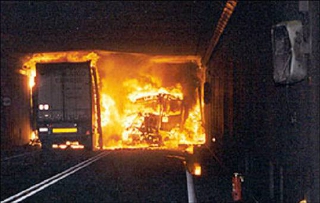
Road Tunnels Manual

Road Tunnels Manual
Tunnels, initially aimed at crossing an obstacle (in general a mountain), have become increasingly complex during recent years, incorporating increasingly complex equipment (including ventilation systems) and methods of operation. Such operation includes the deployment of control and supervision systems that enable the handling of vast amounts of data, and which can accommodate increasingly sophisticated management scenarios.

Following the catastrophes in the Mont Blanc, Tauern and Gotthard (Figure 1) tunnels in the years 1999 and 2001, the need to adopt a holistic approach to tunnel safety was recognized. This resulted in stricter provisions from the tunnel design stage onwards, which have an important impact on specific civil engineering and tunnel equipment requirements.
In general, tunnels are considered as "expensive and risky" works, both with regard to their construction as well as their operation. This "image" makes some countries very reluctant to embark upon the construction of their first or railway tunnels. In order to address such concerns, increasing importance is being given to risk management (including construction and operation costs), accident or fire mitigation during operation and the optimisation of the tunnel facilities at the design, construction and operation stages. This risk and cost management is reinforced through current procurement and financing models for the construction of tunnels, which are increasingly being implemented as "Concession", "Design and Build" or "Private Public Partnership" models.
The chapter entitled Strategic Issues aims to:
This chapter is not designed to be a detailed handbook of the actions required by tunnel owners, or to specify the technical provisions to be implemented by designers, or to determine the tasks to be undertaken by operators to ensure a safe and comfortable tunnel environment. In particular, this chapter does not aim to be a design handbook. Its main objective is to make the reader aware of certain issues, in order to facilitate comprehension of this complex field, to raise awareness of the many possible errors in tunnel operations, and to have a better understanding of optimisation possibilities.
The page entitled Tunnel: a complex system, explains why a tunnel constitutes a "complex system" and lists the main interfaces between Civil Engineering, Ventilation and Safety aspects;
The page Steps of tunnel life analyses the various stages of a tunnel’s life cycle and underlines the key actions of each of these phases;
The page General design of the tunnel (new tunnel) presents the major elements which have to be considered when designing a new tunnel;
The page Renovation - Upgrading of existing tunnels concerns the upgrading and the refurbishment of existing tunnels under operation;
The page Costs of construction - Operation - Upgrading - Financial aspects explains issues relating to construction, operation and renovation costs, as well as the main issues specific to the modes of financing;
The page Complex underground road networks highlights the special features of complex underground and interconnected structures and provides case studies of complex tunnels via numerous monographs.
The page Regulations - Recommendations gives a list of the main recommendations, directives and regulations published by various countries in Europe and elsewhere in the world.